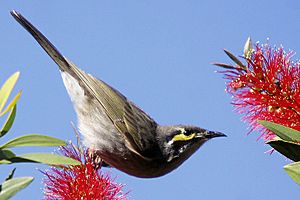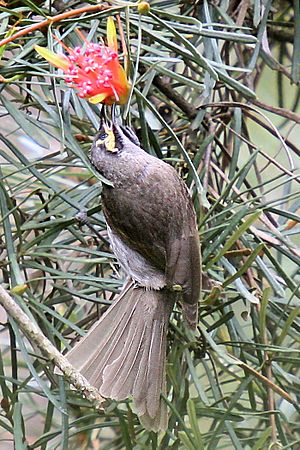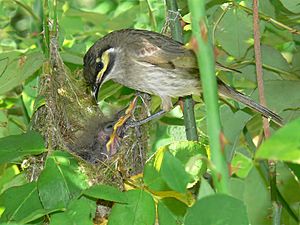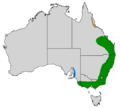Yellow-faced honeyeater facts for kids
Quick facts for kids Yellow-faced honeyeater |
|
|---|---|
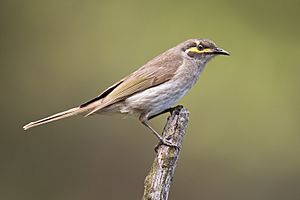 |
|
| Conservation status | |
| Scientific classification | |
| Genus: |
Caligavis
|
| Species: |
chrysops
|
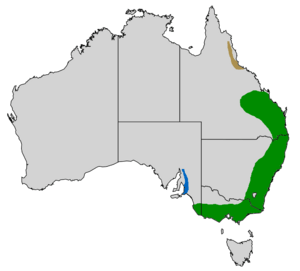 |
|
| Yellow-faced honeyeater natural range subsp. barroni olive subsp. chrysops green subsp. samueli blue |
|
| Synonyms | |
|
|
The yellow-faced honeyeater (Caligavis chrysops) is a small bird. It belongs to the honeyeater family, called Meliphagidae. This bird gets its name from the bright yellow stripes on the sides of its head.
You can often hear its loud, clear call early in the morning. It starts singing about 20 to 30 minutes before the sun comes up! These birds live all over eastern and southeastern Australia. They like open sclerophyll forests, which are woodlands with tough, leathery-leaved trees. You can find them from coastal areas to high mountains. They also live in woodlands along rivers and creeks.
Yellow-faced honeyeaters have shorter beaks than many other honeyeaters. This helps them eat different foods. They eat insects like flies, spiders, and beetles. They also enjoy nectar and pollen from flowers, such as Banksia and Grevillea. Sometimes, they eat soft fruits too. They catch insects while flying or pick them off leaves and bushes. This is called gleaning.
Some yellow-faced honeyeaters stay in one place all year. But many thousands of them migrate north. They fly to southern Queensland between March and May to spend the winter. Then, they return in July and August to have their babies. They breed in southern New South Wales and Victoria. These birds form pairs and build delicate, cup-shaped nests. They usually lay two or three eggs. Sometimes, not many chicks survive. So, the pairs often try to nest several times during the breeding season.
The woodlands where honeyeaters live are changing. This is due to land being cleared, animals grazing, and weeds growing. But the yellow-faced honeyeater is common and found in many places. Because of this, the International Union for the Conservation of Nature (IUCN) says it is of least concern. This means it is not currently in danger of disappearing. In some areas, people see them as a problem in fruit orchards.
Contents
What is a Yellow-faced Honeyeater?
How Was It Discovered?
The yellow-faced honeyeater was first described in 1801. An expert on birds, John Latham, gave it the name Sylvia chrysops. Other scientists later gave it different names. These included Melithreptus gilvicapillus in 1817 and Ptilotis trivirgata in 1869.
The name chrysops comes from ancient Greek words. Chrysos means 'gold' and prosopo means 'face'. This refers to the yellow stripe of feathers on its face.
The bird was once placed in the Meliphaga and then Lichenostomus groups. But in 2011, scientists studied its DNA. They found that Lichenostomus was not a single group. So, the yellow-faced honeyeater was put into a new group called Caligavis. This name comes from Latin words meaning 'mist' or 'obscurity' and 'bird'.
Scientists found that the yellow-faced honeyeater is closely related to two other birds. These are the black-throated honeyeater and the obscure honeyeater. They all live in New Guinea. A study in 2017 showed that the yellow-faced honeyeater's ancestors separated from these other two about seven million years ago.
Are There Different Types?
There are three types, or subspecies, of the yellow-faced honeyeater. Two of these were described in 1912. There are only small differences between them.
- C. c. samueli lives in the Mount Lofty Ranges in South Australia.
- C. c. barroni is found in the Clarke Range and the Atherton Tableland in Queensland.
- The main type is called the "nominate race."
Some experts think the differences between these types are so small that they might not be separate subspecies.
In 1788, a surgeon named John White caught one of these birds. He called it a yellow-faced flycatcher. Later, John Gould gave it the name "yellow-faced honeyeater" in 1848. This is its official name today. It is also sometimes called the yellow-gaped honeyeater. Or, people call it the "quitchup" because of its call.
Appearance and Sounds
What Does It Look Like?
The yellow-faced honeyeater is a medium-small bird. It is mostly greyish-brown. Its common name comes from the clear yellow stripes on the sides of its head.
Here's how to spot one:
- A narrow yellow stripe starts above its beak. It then widens and curves under its eye. This stripe ends in a small white patch of feathers near its ear.
- Above the yellow stripe, there's a black stripe that goes through its eye. This black stripe has a small yellow or off-white patch behind the eye.
- Below the yellow stripe, another clear black stripe runs along its face.
- Its chin, throat, and chest are pale greyish-brown with darker grey streaks. Its belly is light grey.
- The top part of its body is dark greyish-brown to olive-brown.
- Its wing feathers have olive-green edges. These form an olive panel when the wing is folded.
- The beak is black and curves slightly downwards. The inside of its mouth (gape) is cream-colored.
- Its legs and feet are grey-brown.
- Adult birds have dusky blue eyes, while young birds have brown eyes.
Young birds look very much like adults. They have slightly fewer streaks on their chest. Their beak tip is orange-brown, and their gape is yellower. Male and female birds look similar, but males are a little bigger.
Yellow-faced honeyeaters are about 15 to 17.5 centimeters (6 to 7 inches) long. Their wingspan is about 21.5 to 26 centimeters (8.5 to 10 inches). They weigh about 12.5 to 20.5 grams (0.4 to 0.7 ounces).
What Sounds Does It Make?
The yellow-faced honeyeater is one of the first birds you hear in the morning. Its calls are loud and varied. The male bird sings from its perch for up to an hour. It starts singing about 20 to 30 minutes before dawn.
Its song is a happy series of notes that sound like chick-up, chick-up. This is why it's sometimes called the "quitchup." Nearby birds often sing back, repeating the first bird's song.
When defending its area, it makes a long preet sound that goes up at the end. This call is also used during fights. Its alarm call is a loud, trilling whistle. Common calls, which are thought to be contact calls, are lively two-note sounds. These are described as terric, terric, cr-rook, cr-rook, or put-put, put-put.
Where They Live and Travel
Where Do They Live?
The yellow-faced honeyeater lives in many different places. You can find them in open sclerophyll forests. These range from coastal sand dunes to high mountain areas. They are also often found in woodlands along rivers (riparian zones).
They mostly live in open forests with certain types of trees. These include spotted gum, ironbarks, and stringybarks. They prefer areas with a light, shrubby undergrowth. Less often, they live in dry, open forests with other trees like Angophora, Acacia, Banksia, Casuarina, or Callitris. They can also be found in tall, open forests in high mountains.
These birds have been seen in coastal heath areas when banksias are blooming. They also visit flowering mangroves. They can even live in areas with weeds like Scotch broom and blackberries. In towns and cities, they visit orchards, parks, and gardens. Here, they eat cultivated fruit and flowers. They can live in forests that are growing back after fires or logging. However, they are more common in older forests. If they live in woodlands, it's usually near a forest or an area with sclerophyll plants.
Where Can You Find Them?
The yellow-faced honeyeater lives in a wide arc along the eastern coast of Australia. This stretches from near Cooktown in Far North Queensland down to Albury. Then it goes west to the Fleurieu Peninsula and the Mount Lofty Ranges in South Australia.
The number of birds in an area can vary. For example, there might be only 0.01 birds per hectare near Armidale in New South Wales. But there could be 7.8 birds per hectare at Tarnagulla, Victoria. In winter (June and July), there are usually fewer birds in Victoria. But there are more in Queensland because they have migrated north.
How Do They Migrate?
Some yellow-faced honeyeaters stay in one place. But most of them move with the seasons. They migrate north during the day. In autumn (March to May), they fly north along the highlands and coast of eastern Australia. They go to southern Queensland. Then, in spring (August to October), they fly back south.
These birds often travel in groups of 10 to 100 birds. Sometimes, they form very large groups of 1,000 or more! Other bird species might join these groups. These include the white-naped honeyeater, fuscous honeyeater, noisy friarbird, and silvereye. The flocks move quickly, sometimes thousands of birds per hour. In May 1965, over 100,000 birds were seen passing Hastings Point in New South Wales in one day.
Yellow-faced honeyeaters can sense Earth's magnetic field. They use it to find their way when they migrate. Scientists found that their magnetic compass helps them tell the difference between the direction of the equator and the South Pole. They don't just tell north from south. Their flight is generally in one direction. But they don't fly in a straight line. They stay in areas with plants, go through gaps in mountains, and fly around cities.
Scientists used to think that Australian birds migrated mostly because of things like food or water. But the yellow-faced honeyeater shows many behaviors like birds that migrate in the Northern Hemisphere. They get restless before migration each year. They use magnetic fields, the sun, and polarized light to guide them. Their migration plan is based on the magnetic field's inclination.
Daily Life and Reproduction
What Do They Eat?
The yellow-faced honeyeater has a shorter beak than many other honeyeaters. This means it eats a mix of different foods. Its diet includes nectar, pollen, fruit, seeds, honeydew, and insects.
They mostly look for food in trees and bushes. They search among leaves and flowers. Sometimes, they look on branches and tree trunks. They rarely look for food on the ground. Yellow-faced honeyeaters spend about 40% of their time eating nectar. They spend about 60% of their time eating insects.
They catch insects by picking them off surfaces (gleaning). They also fly out to catch them (sallying) or probe into bark cracks. The insects they eat are mainly flies, beetles, and spiders. A study found that many birds had pollen on their beaks and foreheads. This pollen came from silver banksia, heath-leaved banksia, and other plants like mountain devil.
In April and May, before they migrate in autumn, these birds eat more nectar. This helps them gain weight. Their average weight in late autumn is 13% higher than in early spring. This means they start their migration with plenty of fat stored up.
Reproduction and Nests
Yellow-faced honeyeaters form pairs for breeding. Their breeding season runs from July to March. Birds that migrate tend to nest later than those that stay in one place. They build their nests alone in their own areas. Both parents protect their territory from other birds. The male bird is usually more aggressive.
Females lay two or three sets of eggs in one breeding season. They build new nests with the same partner in the same area. Some banded birds have been seen in the same territory for up to five years!
The nest is built in shrubs, usually low to the ground. Nests have been found in prickly coprosma, Cassinia, tea-trees, eucalypts, and acacias. They also nest in garden shrubs. The nest is a delicate, cup-shaped structure. It is wider at the sides and narrower at the top. The female builds the nest. The male often goes with her when she collects materials.
Most nests are made of greenish material. The material changes depending on where they live. In coastal areas, grass is the main material. In mountain forests, the nest is often covered with moss. One bird was even seen pulling long hairs from a koala to use in its nest! The nests are very thin. You can sometimes see the eggs through the walls. They can even fall apart, with eggs or chicks falling out.
The female bird sits on the eggs alone to keep them warm. The eggs are oval, about 21 millimeters (0.8 inches) long and 14 millimeters (0.6 inches) wide. They are pinkish-white with dark reddish-brown spots. They usually lay one to three eggs. The eggs hatch after about two weeks.
After hatching, both parents feed the chicks. They also remove the chicks' waste. The chicks leave the nest after 13 days. They leave their parents' territory about two weeks later.
Not all eggs become grown birds. Sometimes, only 16% of eggs survive to become young birds that can fly. Nests can fail for many reasons. These include hot weather, heavy rain, or human activity. Eggs can be destroyed by brood parasites. These are birds that lay their eggs in other birds' nests. Predators like brown snakes, cats, and currawongs also eat eggs or chicks. Some birds that parasitize yellow-faced honeyeater nests are fan-tailed cuckoos, brush cuckoos, pallid cuckoos, shining bronze-cuckoos, and Horsfield's bronze-cuckoos. If a nest fails or succeeds, the yellow-faced honeyeater will quickly try to nest again.
Conservation Status
Yellow-faced honeyeaters can get tiny creatures called ectoparasites on them. These include mites and ticks. These can affect their health and how well they reproduce.
Honeyeaters need large areas of mature trees to travel along. They also need flowering woodlands for nesting. So, they are affected by land being cleared, animals grazing, and weeds growing. The woodland habitat they prefer is considered an endangered natural community.
However, the yellow-faced honeyeater is common and found in many places. The International Union for the Conservation of Nature (IUCN) says it is of least concern for conservation. This means it is not currently in danger.
One study looked at nests in fragmented habitats. These are areas where the forest is broken up into smaller pieces. The study found that nests closer to the edge of the forest actually had more success than those deeper inside. The yellow-faced honeyeater tends to nest away from the very edge of these forest pieces. Experiments showed that there weren't more predators at the forest edge. This suggests that fragmented habitats might not be as bad as once thought for these birds.
In some areas, people see the yellow-faced honeyeater as a pest. This is because they go into orchards and gardens and damage fruit.
Images for kids
See also
 In Spanish: Mielero carigualdo para niños
In Spanish: Mielero carigualdo para niños




